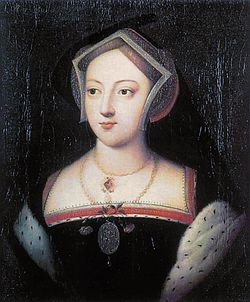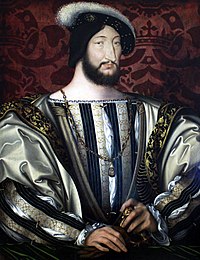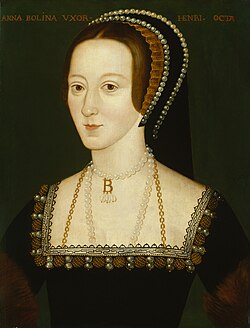
My literary agent and I made a girls’ afternoon out of watching “The Other Boleyn Girl” on opening day. After all the research I did for ROYAL AFFAIRS, my nonfiction debut this June, I found myself wincing in pain. We were watching what I couldn't help referring to as "Betty and Veronica in Tudorland." But this post isn’t intended to debate the artistic merits (or lack thereof) of the film adaptation of Philippa Gregory’s novel, which is in itself alternative history—the other Boleyn history, if you will.
Want to hear about the real Mary Boleyn (1499-1543), her affair with Henry VIII (1491-1547) and her relationship with her relatives?
Mary Boleyn (1499-1543)

The French monarch François I called her his “hackney,” explaining that he loved to ride her. An Italian visitor to François’s court thought her “una grandissima ribald et infame sopre tutte” (a great prostitute and more infamous than all of them). She is probably best remembered as the older sister of Anne Boleyn. What seems clear is that this daughter of Sir Thomas Boleyn and Lady Elizabeth Howard knew how to have fun in bed.
Mary Boleyn possessed the blond, blue-eyed, curvy beauty that was the era’s belle idéale. In 1514, she was a member of the French court in the household of the queen, Henry VIII’s younger sister Mary Tudor. But after Mary’s husband, King Louis XII, died on New Year’s Day in 1515, Mary Boleyn remained at the French court, where she became a lady-in-waiting to the new queen, Claude, the wife of François d'Angoulême. Claude was the older daughter of Louis XII, but France was under Salic law, which prohibited a female from inheriting the throne. So on Louis's death, his son-in-law became king.

Francois I (1494-1547)
Evidently, Mary Boleyn also became the paramour of the new king, François I. But after François tired of Mary, she consoled herself in the arms of enough of his courtiers to create a scandal. In 1519, at the age of twenty, Mary was ignominiously dismissed from Queen Claude’s service and packed back to England, much to the embarrassment and disgrace of her family.
But the Boleyns were a powerful family, so Mary quickly secured a place as a lady-in-waiting to Queen Katherine, the unofficial but de facto usual incubator for a royal mistress. Sure enough, soon after Bessie Blount delivered Henry’s son in 1519, the regal eye began to rove, alighting before long on the new flavor in his wife’s retinue.
His affair with Mary Boleyn was reputedly short but intense. And in a situation similar to Bessie Blount’s, Henry saw to it that Mary made a financially brilliant marriage. So, on February 4, 1520, at the Chapel Royal in Greenwich, Mary Boleyn wed William Carey, one of Henry’s favorite Gentlemen of the Bedchamber. His Majesty himself attended the wedding, bestowing an offering of six shillings, eightpence in the chapel. However, some believe that Mary was still Henry’s mistress at the time she was wed to William Carey.
 (Henry VIII 1491-1547)
(Henry VIII 1491-1547)In any case, Henry was so immensely grateful for the gift of Mary’s favors, he enriched her father as well as her new husband. Sir Thomas Boleyn was made Viscount Rochford, and William Carey’s coffers were vastly enlarged.
In 1525, Mary gave birth to a son, who she named Henry. The king never claimed paternity, and Mary never pressed the point, so the boy was likely her husband’s. But Mary’s motherhood had the effect of dampening Henry’s lust, just as it had more or less killed his ardor for Bessie Blount soon after she gave birth.
Yet there was another reason Mary was supplanted: Henry had fallen madly in lust with her younger sister, Anne.
Mary wasn’t too upset about it. She devoted herself to her husband and their two children. But in 1528, after the thirty-two-year-old William Carey died during the outbreak of the sweating sickness, Mary found herself buried under a mound of debts. Petitions to her family were fruitless. Requests to Henry fell on deaf ears as well. Only Anne, who at the time of William’s death was the king’s inamorata, managed to procure something for her sister—an annual pension of £100 (nearly $72,000 today), and an elaborately wrought golden cup.
 Anne Boleyn (1500 (?) - 1536)
Anne Boleyn (1500 (?) - 1536)In 1534, Mary secretly married William Stafford, a commoner without rank of any kind. She bore him two children. For wedding a man so far beneath her station, the Boleyns disowned her for good, but Mary emphatically averred, “For well I might a’ had a greater man of birth, but I assure you I could never a’ had one that loved me so well. I had rather beg my bread with him than be the greatest queen in Christendom,” a rather pointed swipe at her sister, as well as a triumphant declaration of True Love. But the jibe struck too close to Anne’s bones, and Anne, now queen, declared that Mary and her husband would never again be received at court.
Her ostracism was probably a blessing; Mary was well rid of the vipers’ nest of the Tudor court. She rusticated with her small family at Rochford in Essex while Anne and their brother George tasted the full measure of Henry’s rough justice. Mary did not visit her siblings as they waited in the Tower for the executioner’s blade to end their lives. Perhaps she was cannier than she’d been credited; she deliberately remained as far from the madness as possible, the better to avoid getting swept into the bloody dustbin of her family’s history.
Mary died at home on July 19, 1543.
Her son, Henry Carey, was eventually made a Knight of the Garter by Elizabeth I. Mary’s daughter Catherine became a maid of honor to both Anne of Cleves and Kathryn Howard. One of Catherine Carey’s daughters, Lettice Knollys, was Queen Elizabeth’s bosom companion, lady-in-waiting—and later, her rival and enemy, after she married Robert Dudley, the great love of Elizabeth’s life.
Mary Boleyn’s twentieth-century descendants include Winston Churchill; Elizabeth Bowes-Lyon (the mother of Elizabeth II); Diana, Princess of Wales; and Sarah Ferguson.
Stranger than fiction? Better than fiction? What other historical personages can you think of who had more more fascinating (even juicy) lives than their fictional avatars?








.jpg)


16 comments:
The real story is even better than fiction! That was a fantastic blog! I really enjoyed it!
Thank you so much! I had so much fun writing ROYAL AFFAIRS because I discovered so many amazing real-life stories. Wait till you read about Hortense Mancini, one of Charles II's many mistresses, a corss-dressing, pistol and sword wielding bisexual beauty who ran away from her abusive husband disguised as a man! And all true!!
Thank you for this update--I just came from the movie --which I totally enjoyed and decided to research the real truth of Mary on the internet and found your blog.
A Kansan
Well, thanks, Kansas, for finding me! I guess there's no place like [my] home [page] after all. :)
Please feel free to stop by often to check out other discussions regarding some of the most scandalous royal affairs and the real stories of the key players.
I always marvel at why hollywood must add untrue details to these storys which are facinating to begin with.
Thanks for clearing it up!
I hope to read your book soon.
The last paragraph states that Mary Bowes-Lyon is the mother of Elizabeth II. The Queen Mother's name was Elizabeth Bowes-Lyon.
Whoops -- a typo; I'll fix it right away. Thanks so much for catching it!!
I'm a 14 year-old from Kansas. ^^ But in all the material I've read Mary is the younger sister and Anne, the elder.
I loved this story. I have yet not seen the movie but I am in the process of reading the book. I believe I adore this story so much due to mine having 4 adult sisters. Two of which remind me of the conniving sister and the other two more like myself. But if we had lived back then I think I would play the role of Mary, since she is the one whom always just does what she's told. My sister's however always go out on their own whims. So the sibling rivalry in this story and the outcome of it makes me cry every time I read it.
Amy Jo, I can relate! I'm the older sister and always did what my parents told me, while my younger sister managed to do rebellious things or talk back to our parents and get away with it. Any time I did something even slightly rebellious, or used bad language I got punished immediately!
Yet I love the fact that in real-life Mary, the well-behaved sister, ended up in a happy marriage (and with her head on her shoulders).
I am glad someone was also cringing while watching this movie! While it was beautifully made, and I love watch movies about Anne, it really butchered the true story.
One correction for your post though... François I was not the son of King Louise XII. His wife, Queen Claude was the daughter of Kind Louise XII, and while Salic Law forbid the crown be passed down to a woman, François was the heir apparent through his father Charles d'Anguoleme, the Kings cousin.
Misty, you're absolutely right!! Yikes, how did I let that goof get published! I'm off to change it -- and I thank you for stopping by and pointing it out!
Please visit often; your comments are always welcome!
Wow i never knew that that was really
sad now i really want to see the movie...and i feel kinda bad for the boleyns too
I've been looking for Sarah Ferguson's links to Mary Boleyn. All I can find, however, is her link to Princess Margaret Tudor. Are you able to show the connexion there?
Thanks.
Hi, SupaSal! Thanks for visiting.
I'm on deadline right now, but I'll try to do some delving when I catch my breath, so I can answer your question.
Thank you Leslie! This is great info for my report on Anne Boleyn! The movie just stunk up my report! Does anybody have god links for pics of Sir Thomas Boleyn and Lady Elizabeth Howard? Thanks!
I like reading all the different viewpoints one thing everyone. Except showtime can agree on is that Henry viii was a bloated caustive nasty slob.. I look forward to reading more,,
Post a Comment